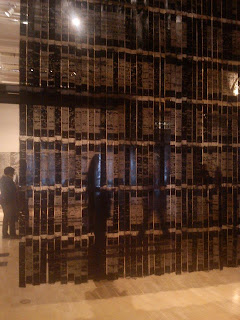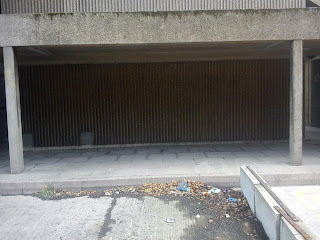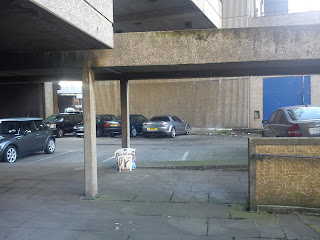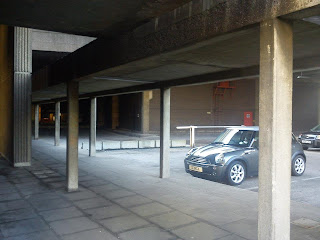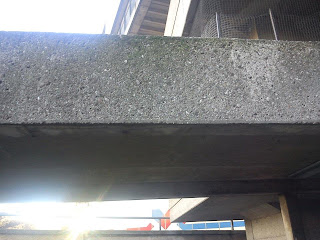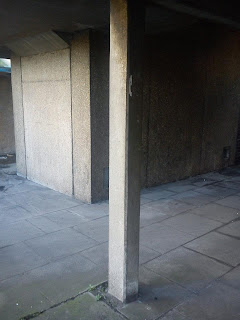Thursday, 15 December 2011
Precedent: Brutalist Architecture 16.12.11
Examples of Brutalist Architecture. Similar in style to the Birmingham Central Library and its Bus Station
Roberts Library
"Habitat"Brutalist Architecture 16.12.11
The Birmingham library is a Brutalist peice of architecture. One of Brutalist architectures main charactoristics is the use of conctrete in thre design. This type of architecture has often been critisised as being ugly. The choice of this design for Birmingham’s library infers the idealist approach the city had at the time. As ever with the constantly changing nature of Birmingham, this movement was soon replaced and the superseded brutalist typology became increasingly disliked.
http://en.wikipedia.org/wiki/Brutalist_architecture
http://en.wikipedia.org/wiki/Brutalist_architecture
Flash Mob 21.10.11
A flash mob (or flashmob) is a group of people who assemble suddenly in a public place, perform an unusual and sometimes seemingly pointless act for a brief time, then disperse, often for the purposes of entertainment, satire, artistic expression or—in rare cases—violence. Flash mobs are organized via telecommunications, social media, or viral emails.
The term, coined in 2003, is generally not applied to events and performances organized for the purposes of politics (such as protests), commercial advertisement, publicity stunts that involve public relation firms, or paid professionals. In these cases of a planned purpose for the social activity in question, the term smart mobs is often applied instead.
Origins
First flash mob
One of the first flash mobs was created in Manhattan in May 2003, by Bill Wasik, senior editor of Harper's Magazine. The first attempt was unsuccessful after the targeted retail store was tipped off about the plan for people to gather.Wasik avoided such problems during the second flash mob, which occurred on June 3, 2003, at Macy's department store, by sending participants to preliminary staging areas – in four prearranged Manhattan bars – where they received further instructions about the ultimate event and location just before the event began.
More than 130 people converged upon the ninth floor rug department of the store, gathering around an expensive rug. Anyone approached by a sales assistant was advised to say that the gatherers lived together in a warehouse on the outskirts of New York, that they were shopping for a "love rug", and that they made all their purchase decisions as a group.Subsequently, 200 people flooded the lobby and mezzanine of the Hyatt hotel in synchronized applause for about 15 seconds, and a shoe boutique in SoHo was invaded by participants pretending to be tourists on a bus trip.
Wasik claimed that he created flash mobs as a social experiment designed to poke fun at hipsters and to highlight the cultural atmosphere of conformity and of wanting to be an insider or part of "the next big thing". The Vancouver Sun wrote, "It may have backfired on him ... [Wasik] may instead have ended up giving conformity a vehicle that allowed it to appear nonconforming." In another interview he said "the mobs started as a kind of playful social experiment meant to encourage spontaneity and big gatherings to temporarily take over commercial and public areas simply to show that they could".
Flash mobs began as a form of performance art.While they started as an apolitical act, flash mobs may share superficial similarities to political demonstrations. Flash mobs can be seen as a specialized form of smart mob, a term and concept proposed by author Howard Rheingold in his 2002 book Smart Mobs: The Next Social Revolution.
Notable flash mobs
Silent disco
Another example of a well known flash mob was the April 2006 silent disco in London. At various London Underground stations, people gathered with their portable music devices, and at a set time began dancing to their music. It was reported that more than 4,000 people participated at London Victoria station. This had an impact on the regular service of the system enough for the city's police to begin crowd control and slowly clear people. Since 2006, there have been several flash mobs in the London Underground, including subsequent silent discos comparable in size.
Worldwide Pillow Fight Day
Worldwide Pillow Fight Day (or International Pillow Fight Day) was a pillow fight flash mob that took place on March 22, 2008. Over 25 cities around the globe participated in the first "international flash mob", which was the world's largest flash mob to date. According to The Wall Street Journal, more than 5,000 participated in New York City, overtaking London's 2006 Silent Disco gathering as the largest recorded flash mob. Word spread via social networking sites, including Facebook, Myspace, private blogs, public forums, personal websites, as well as by word of mouth, text messaging, and email. Participating cities included Atlanta, Beirut, Boston, Budapest, Chicago, Copenhagen, Dublin, Houston, Huntsville, London, Los Angeles, Melbourne, New York City, Paris, Pécs, Shanghai, Stockholm, Sydney, Székesfehérvár, Szombathely, Vancouver, Washington, D.C., and Zurich.
Wednesday, 14 December 2011
Co.Lab Precedent 15.12.11
Robert Smithson. Hotel Palenque, 1969-72
http://
Photographs: The Bus Station Corners 25.11.11
these are photographs of more detailed areas of the shelter and the surrounding context. concentrating on edges and corners. obseervation of texture is essential for the next stage of our intentions

Industrial archaeology 16.11.11
From Wikipedia, the free encyclopedia
Industrial archaeology, like other branches of archaeology, is the study of material culture from the past, but with a focus on industry. This type of archaeology is the group in which the unused bus shelter resides.
Post-mortem (disambiguation)
in our documentation of the site we aim to treat t as a post mortem. this approach was chosen by the group as we feel that the bus shelter is a dead peice of architecture as with its immediate surrounding context. I the location was intended to be one teeming with the hustle and bustle of life; busy and known as a landmark. it wasnt to be
ttp://en.wikipedia.org/wiki/
Archaeology 16.11.11
We chose to take an archaeological approach to documenting our study of the bus shelter because it inferred the object has a high value. Because the structure is due to be demolished sometime in the near future we are creating detailed recordings of the structure that will eventually be the only remnants of the object. we treat it as a historical site trying to uncover its past and to document our findings using different media forms such as photographs, sketches, Sound bites, rubbings and collection of 'artifacts'
http://en.wikipedia.org/wiki/
Adaptive Reuse 16.11.11
Our ideas have to do with the recycling of the bus shelter and the reuse of something; transforming it into something new,relevent, contemporary
http://en.wikipedia.org/wiki/
Photographs: The Bus Station Panorama 11.11.11
Panoramic view of the bus shelter; to get a better idea of its form, the typography and surrounding context.

Photographs: Precedents Lost in Lace 04.11.11
these are photographs from the lost in lace exibition that took place. could it be possible that we could use some of the design concepts and ideas an use it for our project?

Subscribe to:
Comments (Atom)






























